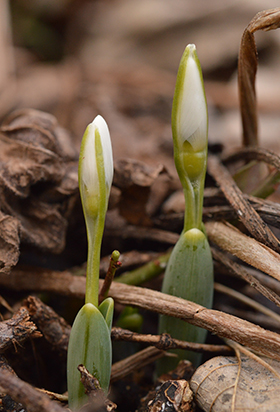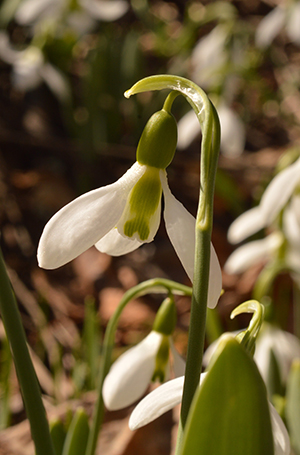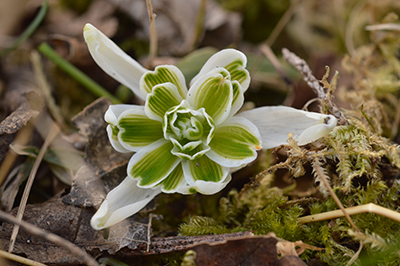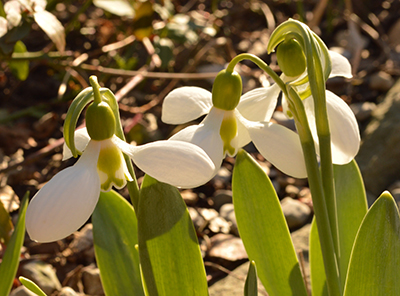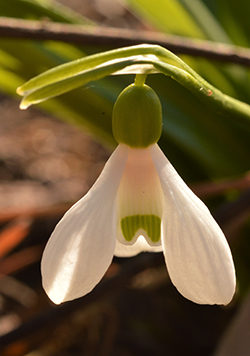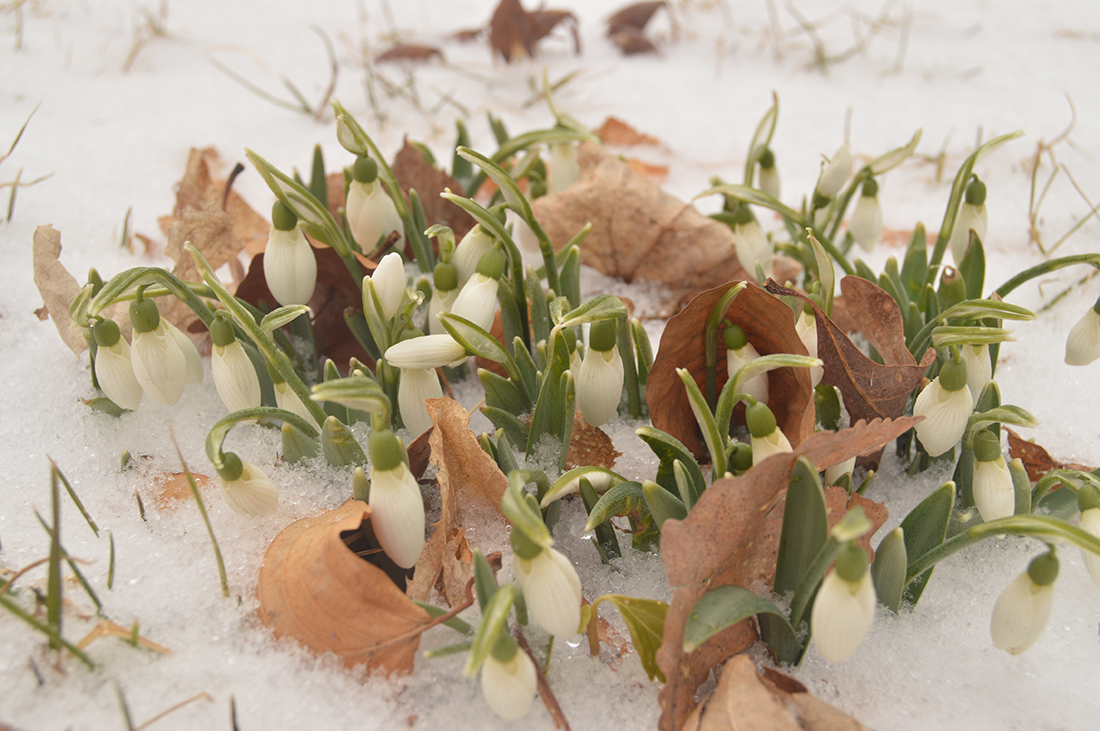Every autumn, gardeners visit their favorite garden center and are confronted by rack upon rack of rather unappealing appearing "bulbs." Occasionally, a gardener will take a leap of faith and buy a few of the dry, papery brown objects in the hopes that flowers, similar to those prominently presented on the display will magically appear the following spring. And magically, appear they do! With the first promise of warmer weather, bulbs begin to awaken and start their spring "symphony" of color. Of the bevy of bulbs available to brighten your garden, there is none as iconic nor as willing to lead the symphony, as the white flowering Snowdrop.
Snowdrops are botanically known as Galanthus with roughly 20 species stretching from the Pyrenees of northern Spain and southern France, East through southern Poland and Italy, and all the way to Syria and northern Iran. Although a member of the Amaryllis family or Amaryllidaceae, their physical appearance certainly does not bear any resemblance to the Amaryllis flowers that adorn many a January windowsill. I realize it will never catch on, but plants growing from dormant underground structures should technically be called geophytes, not bulbs. A true bulb consists of layers of modified leaves, such as seen when slicing open an onion. Aside from true bulbs, geophytes include corms and rhizomes, which are actually modified stems and are solid when cut open. Snowdrops are a true bulb, composed of modified leaves with each bulb roughly the size of a thumbnail. The common name of Snowdrop first appeared in 1663 in the book Great Herbal written by the English botanist John Gerard (1545–1610). The origin of the word is uncertain, although it certainly does look like a drop of snow emerging from the ground. Galanthus was initially penned in 1735 by the Swedish botanist Carl Linnaeus (1717–1778) in his first major document named Systema Naturae. Honoring the milky white flower, the name is derived from the Greek Gála or milk and Ánthos for flower.
The most common species planted in gardens, and very deservedly so I might add, is Galanthus nivalis. This species is also the type species for the genus, against which all species are evaluated and compared. This species was also named by Linnaeus in 1753, with the species epithet coming from the Latin meaning "of the snow" or "snow-covered." Typical to the genus, each bulb produces two linear leaves that ultimately grow to 6–8" long. The flower scape emerges from in-between the leaves when they are merely 1–2" tall as seen at left. The flower scape ultimately stretches to 6–8" tall as well, and terminates in what appears like a shepherd's crook, with the flower dangling from the center of the crook (see image below of Galanthus elwesii). When the flower initially emerges from between the leaves, the bud is held upright and is enclosed by a protective leafy bract or spathe. The spathe consists of two modified leaves called spathe valves and two transparent membranes. The spathe valves are located on either side of the flower bud and appear as slender green lines, as seen in the image at left.
The two transparent membranes are connected to the spathe valves and wrap around the bud. As the bud expands, the membranes split open and fall away, while the 2 spathe valves elongate and curl downward, forming the "shepherd's crook," as the image of Galanthus elwesii depicts at right. As the spathe valves elongate, the flower bud transitions from an upright bud to a dangling flower, located near the center of the spathe valves. An incredible "dance," and fun to watch evolve if time permits!
As is typical to all members of the genus, the flowers are composed of 6 white tepals. A tepal is an organ whose function is to attract pollinators, but there is no true distinction between the inner petals and the outer leaf-like sepals. The 3 outer tepals are usually pure white in color with a longer and more linear shape, although some seedlings have a more rounded form. They are convex in cross section and are roughly ¾" long for this species. Initially hanging downward, they flair outwards on warmer days, giving the flower a greater presence and exposing the three inner tepals to pollinators. The inner 3 tepals are bilobed at their tip, roughly ⅓ the length of the outer whirl, and grow tightly together to form a central cone. Each inner tepal bears green markings, which vary by species. G. nivalis has a single green mark spanning the two lobes at the tip of the tepal. These markings not only act as nectar guides for pollinators, but are photosynthetic as well, and aid in producing sugars for the production of seed.
Snowdrops go dormant by late May. The compressed growing period pressures the genus to produce as many carbohydrates as possible for generating seed and developing new bulbs for the following year. Albeit small, these green markings aid in the production of the needed sugars! Interestingly, the foliage and tepals also contain small air-filled spaces that allow the flowers to tolerate subfreezing temperatures as they begin to bloom. The globe shaped ovary is located above the tepals, with the small black seeds maturing in mid- to late-May. The seeds have an attached lipid rich structure called an elaiosome, which cleverly allows dispersal of the seed. This structure attracts ants, who take the seed back to their colony in order to feed the elaiosome to the developing young. Once consumed, the now useless seed is discarded and allowed to germinate.
'Flora Plena' is one of several cultivars that has numerous additional tepals, producing a "double" flower (pictured above). When viewed from above, the additional whirls of tepals gives the flower a fuller appearance, much like how a hoop petticoat impacts a dress. Unfortunately, the extra tepals also add weight to the flower, causing it to droop, meaning the details of the bloom are not evident unless it is physically turned towards the viewer. It is also one of the last forms to bloom, typically still attractive and in color in April!
Another readily available species is the formerly mentioned Galanthus elwesii. The plant resembles its cousin in all aspects, except it is larger with the outer tepals reaching an inch or longer in length. They are often the first species to emerge and feature green markings on both the upper and lower ends of the inner tepals. They can even be connected, as seen at right. The larger outer tepals results in a flower upwards of 2" in diameter when fully open! The species is named in honor of the British botanist and entomologist Henry John Elwes (1846–1922), who came across a mass of large flowered Snowdrops in 1874 while botanizing in the mountainous regions near Smyrna, Greece. In 1875, the English botanist Dalton Hooker (1817–1911) commemorated Elwes with the species epithet. Interestingly, the plant that Elwes found was actually a previously described species named Galanthus gracilis and Hooker's species name was used to describe another, as of yet unnamed large flowered species!
Another delicate and very attractive species is Galanthus ikariae. Named by John Gilbert Baker (1834–1920) in 1893, it is native to several Greek islands in the Aegean Sea, including the island of Ikaria for which it is named. If the island's name sounds familiar, it is named after Icarus, who in Greek legend escaped from King Minos by fabricating wings from feathers connected by wax. When he flew too close to the sun, the wax melted and he fell to Earth. Legend has it he was buried on this island that bears his name! This species bears smaller pendant flowers up to 1" long and a single green mark on the tips of the inner, bilobed tepals (pictured at left). Often, this green mark will extend half way or further up these tepals. The foliage is glossy and more attractive than the mat-green forms, growing to 6–8" tall. It is not ideal for plugging into turf, since the reflective foliage does not blend well with turf grass. In the wild, the plant is often found in river valleys, growing with Cyclamen hederifolium in deep humus rich soils. It has also been found in upland gravelly soils in scrubby growth. The plant is somewhat less winter hardy, but I have not had any issues in over 30 years of growing the plant. Unfortunately, it does not appear to naturalize as readily as other species.
Snowdrops are an easily grown bulb, providing your garden is zone 7 or colder, since they resent summer heat. The challenge is often getting them established. Due to their smaller size, some of the bulbs desiccate before they arrive on retail shelves. The most successful time to transplant is while the foliage is still green and they are in active growth! All the species enjoy well-drained soils and thrive in full sun or in locations beneath deciduous trees. Plant to a depth of three times their diameter or around 3" deep. They are best planted in random groups with 3–6 per hole to provide a more mature appearance. Consider interplanting among deciduous shrubs such as early blooming Quince (Chaenomeles) and Witch Hazel (Hamamelis), or at the base of Red Stemmed Willow (Salix alba 'Britzensis'). Or plant in turf, providing you can wait until the second week of May to make the first cut, allowing for the foliage to go dormant before it is cut.
Snowdrops are a remarkably easy and rewarding bulb for your garden, typically the first bulb, or if I may, geophyte to awaken in the NJ garden. I should also mention the vast number of unusual Snowdrop selections available from specialty nurseries with unique green or yellow markings. These selections can drain the checking account, yet in moderation they will enhance your appreciation for this plant! Whether ordering bulbs next fall or plants this spring, Snowdrops will delight you for years to come as they start your spring symphony of garden color.


